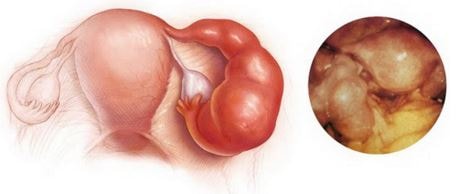Oophoritis
What is oophoritis?
Oophoritis term refers to inflammatory condition of single or pair of ovaries. Oophoritis is generally used to describe the inflammatory condition of pelvic inflammatory disease.

Usually oophoritis is associated with salpingitis, the infection affects fallopian tubes and gradually it spread internal pelvic organs including ovaries. Ovaries are responsible for egg production and oophoritis can interfere with fertility.
What is salpingo oophoritis?
Salpingo oophoritis term is used for describing the physical condition which is associated for both inflammatory condition of fallopian tubes and ovaries.
From bacterial colonization, infection extends from the cervix to the uterus, fallopian tubes, and ovaries. The two responsible bacterial colonizations are Gonorrhea and Chlamydia lead to infection of the cervix and aid to develop other microorganism for invading the fallopian tubes and reach to the ovaries. This condition is known as a tubo-ovarian abscess (TOA) which gradually turns to salpingo oophoritis.
Symptoms of oophoritis
In the initial stage the following symptoms are considered:
- The lower abdominal pain on both the sides, especially during menstrual cycle.
- Heavy vaginal bleeding during menstrual cycle
- Discomfort and pain during sexual intercourse
- Foul odour vaginal discharge
- Polyurea (frequent urination)
- Burning sensation during micturition
- Malice
- During walking lower abdominal discomfort arises
- Pain extends up to the liver
In advanced stage, following are the symptoms
- Need to hospitalize the patient due to severe abdominal pain and tenderness.
- Fever
- If tubo-ovarian abscess become ruptured, then general peritonitis occur.
Causes
This condition is common among young, sexually active females. The infectious agents are invading to the fallopian tubes and ovaries through the vaginal route. The following are the different possibilities through which infectious agents able to create tubo-ovarian abscess.
- The partner is having STDs
- Insertion IUD without following sterilization and also lack of personal hygiene cause the possibilities infectious agent’s entrance.
- Douching also promotes the infection of the uterus and gradually spread to the fallopian tubes and ovaries.
- Infections of the cervix also lead to tubo-ovarian abscess formation.
Diagnosis
Following tests help to identify the oophoritis:
- Thorough knowledge of the patient history and detailed knowledge of the sign and symptoms of the patient
- Pelvic examination
- Culture test for vaginal discharge, especially which is coming from the cervix
- Pelvic ultrasound is the conventional method for obtaining the images of the fallopian tubes and ovaries. This method is harmless, as it uses sound waves.
- Colpocentesis: this is a test conducted through a needle enters into the uppermost part of the vagina. This needle presses the tube and ovaries for secreting the accumulated fluid. Then collect the fluid and send for laboratory test to diagnose the infecting bacteria.
- Laparoscopic examinations: If other test results are not providing satisfactory result, then laparoscopy is conducted. In this test small abdominal insertion is required for entering the laproscope. This is a medical examining device which has a light at the tip, after entering it into the abdominal cavity; it provides a clear view of the pelvic organs.
Treatment
The treatment method is totally depends upon patient condition, How sever the infection and how much patient is affected.
- Initially patient is treated with antibiotic therapy to stop the microbial growth and also to kill the germs.
- For symptomatic relief, application of hot pad at the lower abdomen. This may helps to reduction of pain.
- Warm bath is also recommended for 2-3 time a day for 10-15 minutes for reduction of the symptoms.
- Avoidance of douching
- Avoidance of sexual activity till the infection becomes cure.
Surgical therapy
If above mentioned therapies are not providing improvement of the patient condition, the surgical intervention is recommended. The aim of the surgical intervention is different according to the patient condition, which include:
- Rapture of the tubo-ovarian abscess.
- Removal of the tubo-ovarian abscess.
- Removal of the ovaries (hystectomy).
- Pre-operative tests should be done appropriately such as heart condition, blood tests for glucose, total blood count and lung X-ray is also required.
- Before surgery patient and patient representative should inform about the treatment plan and also its outcome. During surgery, if general anesthesia is used, then proper care is required.
- After surgery patient need to analgesic treatment for lessen the pain, and other post operative care should follow properly.
References
- http://www.thehutchinsonclinic.co.uk/PDF/pg471.pdf
- http://www.merriam-webster.com/medical/salpingo-oophoritis
- Diagnosis Treatment of Salpingo-Oophoritis at http://link.springer.com/chapter/10.1007/978-94-009-7464-7_5#page-1
